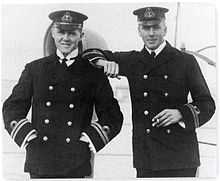HMS E9
| Career | |
|---|---|
| Name: | HMS E9 |
| Builder: | Vickers, Barrow |
| Laid down: | 1 June 1912 |
| Commissioned: | 18 June 1914 |
| Fate: | Scuttled, 3 April 1918 |
| General characteristics | |
| Class & type: | E class submarine |
| Displacement: |
667 long tons (678 t) surfaced 807 long tons (820 t) submerged |
| Length: | 181 ft (55 m) |
| Beam: | 15 ft (4.6 m) |
| Propulsion: |
2 × 1,600 hp (1,193 kW) diesels 2 × 840 hp (626 kW) electric 2 propellers |
| Speed: |
15.25 knots (28.24 km/h; 17.55 mph) surfaced 10.25 knots (18.98 km/h; 11.80 mph) submerged |
| Range: |
3,000 nmi (5,600 km) at 10 kn (19 km/h; 12 mph) 65 nmi (120 km) at 5 kn (9.3 km/h; 5.8 mph) |
| Complement: | 30 |
| Armament: |
• 5 × 18 in (457 mm) torpedo tubes (2 bow, 2 beam, 1 stern) • 1 × 12-pounder gun |
HMS E9 was a British E class submarine built by Vickers, Barrow. She was laid down on 1 June 1912 and was commissioned on 18 June 1914.
Service history

At dawn on 13 September 1914, the submarine, commanded by Lieutenant-Commander Horton, torpedoed the German light cruiser SMS Hela six miles southwest of Heligoland. Hela was hit amidships with the two torpedoes, fired from a range of 600 yards. All but two of her crew were rescued by the German submarine U-18 and another German ship. Although pursued most of the day by German naval forces, E9 managed to reach Harwich safely.[1] Three weeks later, Horton sank the German destroyer S 116 off the mouth of the River Ems. For sinking the cruiser and the destroyer, Horton was awarded the Distinguished Service Order (DSO).
E9 was scuttled outside Helsinki (Helsingfors) 1.5 nautical miles (2.8 km; 1.7 mi) off Grohara Light in the Gulf of Finland on 3 April 1918 to avoid seizure by advancing German forces.
HMS E9 was salvaged for breaking in Finland in August 1953.
References
- ↑ "Admiral Sir Max Kennedy Horton, RN". uboat.net. Retrieved 2006-11-26.
- Submarines, war beneath the waves, from 1776 to the present day, by Robert Hutchinson